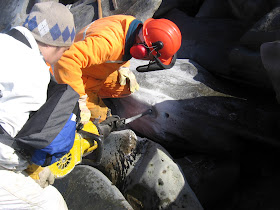Yoshi Tanaka along the cliffs. Our target is the point in the distance and the stacks of concretions on the shoreline.
My adviser Ewan Fordyce examining the base of the cliffs.
Yoshi and I using the pionjar rock drill to extract a small vertebrate bone (or tooth).
Ewan using the rock drill. The drill weighs about 70 lbs, has an 18" bit, and is a percussive drill: it is effectively a combination drill and jackhammer. In other words, it's a jackhammer with a rotating chisel bit.
The skeletal element in question is in a shell-rich unit in extremely hard, calcium carbonate-cemented sandstone, and located about 4-5" to the right of the bit. We're drilling a couple holes here in a layer just below it.
Due to the low rotation speed of the bit, someone with gloves (Ewan in this case) can hold the bit in place in order to start a bore hole.
The rock drill is a bit of a beast to work with and bucks around a lot while at the same time being awkwardly proportioned and weighted and spitting out oil and foul smelling exhaust; it is relatively straightforward to use vertically, but using it at an angle is a constant struggle.
Fellow student Cheng-Hsiu Tsai starts a second bore hole.
Step two: after the bore holes are drilled, pairs of wedges with a half-circle cross section are placed in, and a wedge between them.
Another view of the wedges. At this stage, the wedges can be driven in by hammer (the long way), or a non-rotating "hammer bit" can be placed into the business end of the rock drill. This bit has a cup on the end, and if properly coaxed, will hammer the wedge into the rock. With two wedges, the rock drill has to be alternated from one to the other to ensure even splitting.
Yoshi (left), myself (middle), and Tsai (right) examining a tiny bit of bone in a very, very large boulder.
This was a pain in the ass: at shoulder height, three people are required, and a hook can be looped over a support - in this case an estwing "super pick"; not only does this allow for support, but the two can also use the cross beam support to push the drill into the rock. Minutes later, Yoshi unfortunately found another bone - this time, at eye level.
Yoshi (right), Tsai (middle) and myself (left) after an arduous walk back with ~120 pounds of rock drill & bits and wedges, and ~60 pounds of concretion fragments (with tiny bones). Tsai had some awesome oil splatter on his face (from the rock drill) which is only partially cleaned off here.














But whose is this bones? It's very interesting!
ReplyDeleteWe don't really know yet, because they haven't been prepared yet. One or two appear to be bird bones, another appears to be a shark tooth, and another is probably a piece of turtle shell. There are several other bone fragments which we can't identify.
ReplyDeleteSo, it's just a "mixture" of bones... And what were the conditions of burial: it was the shallow or deep part of the sea?
ReplyDeleteWell, it's not really a mixture like what you'd expect in a bonebed. These bones and teeth do represent a mix of species, however - which is the norm for marine vertebrate fossil assemblages. These skeletal elements were occurring in storm- and fair-weather deposited shell beds, suggesting relatively shallow "inner shelf" deposition.
ReplyDeleteOk, I understand you! So, the probability to find complete skeletons of marine animals in this area is very small?
ReplyDelete